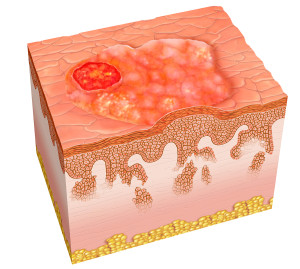Squamous cell carcinoma is a malignant skin cancer that is not as frequent as basal cell carcinoma, but is more dangerous as it tends to metastasize early and thus leads to an increased mortality. It is difficult to know how often this skin cancer occurs as many practitioners in the U.S. will remove this cancer and do not always report it to the cancer authorities. However, we know from Australian studies, which likely are more accurate, that the cases of skin cancer per year are as follows:
Skin cancer cases per year in Australia:
|
The clinical presentation of a new squamous cell cancer is a red, hardened papule that appears fairly rapidly within a few weeks and grows, if left alone, to a large nodule, which eventually will ulcerate and metastasize to the local lymph glands. Here is a link to a picture of squamous cell carcinoma.
There are some other precancerous lesions (Bowen’s disease, cutaneous horn, chronic ulcers, scar tissues, radiation dermatitis etc.) that can be precursor sites for the development of squamous cell carcinomas. In the mucous membranes of smokers and people with heavy alcohol consumption this skin cancer can develop from an area of leukoplakia. And some giant warty lesions on male genitalia that are associated with human papilloma virus, can also suddenly turn into squamous cell carcinoma, which can be very difficult for the dermatologist to treat.
In patients with a weakened immune system following organ transplants squamous cell cancer is more frequently seen, as there is some evidence that many smaller squamous cancers may normally be fought off by the immune system and in its absence more of such tumors occur.
The same is true for AIDS patients whose immune system is weakened from the AIDS virus. Because of this human papilloma virus(HPV) and some other viruses with oncogenic actions can multiply easier and this likely is responsible for the 40-fold increased incidence of anogenital squamous cell cancer in AIDS patients when compared to the non AIDS population. Similar reasoning is true for the Kaposi sarcoma in AIDS patients, a skin tumor of the subcutaneous layer of the skin, which occurs about 300-fold more often than in the non AIDS population.
References:
1. Kripke ML, Sass ER,eds.”Antigenicity of murine skin tumors induced by UV light”.JNCI 1974;53:1333-1336.
2. Kripke ML. “Immunology and photocarcinogenenis”. J. Am. Acad.Dermatol. 1986;14:149-155.
3. Potter M.”Percivall Pott’s contribution to cancer research”. NCI Monogr.1963;10:1.
4. COMS Group: Collaborative ocular melanoma study manual of procedures. National Technical Information Service. Springfield,VA, 1989.
5. Cancer: Principles &Practice of Oncology. 4th edition. Edited by Vincent T. DeVita, Jr. et al. Lippincott, Philadelphia,PA, 1993. Chapter on Cancer of the skin.
6. Cancer: Principles&Practice of Oncology. 5th edition, volume 2. Edited by Vincent T. DeVita, Jr. et al. Lippincott-Raven Publ., Philadelphia,PA, 1997. Chapter on Cancer of the skin.
7. Conn’s Current Therapy 2004, 56th ed., Copyright © 2004 Elsevier
8. Ferri: Ferri’s Clinical Advisor: Instant Diagnosis and Treatment, 2004 ed., Copyright © 2004 Mosby, Inc







